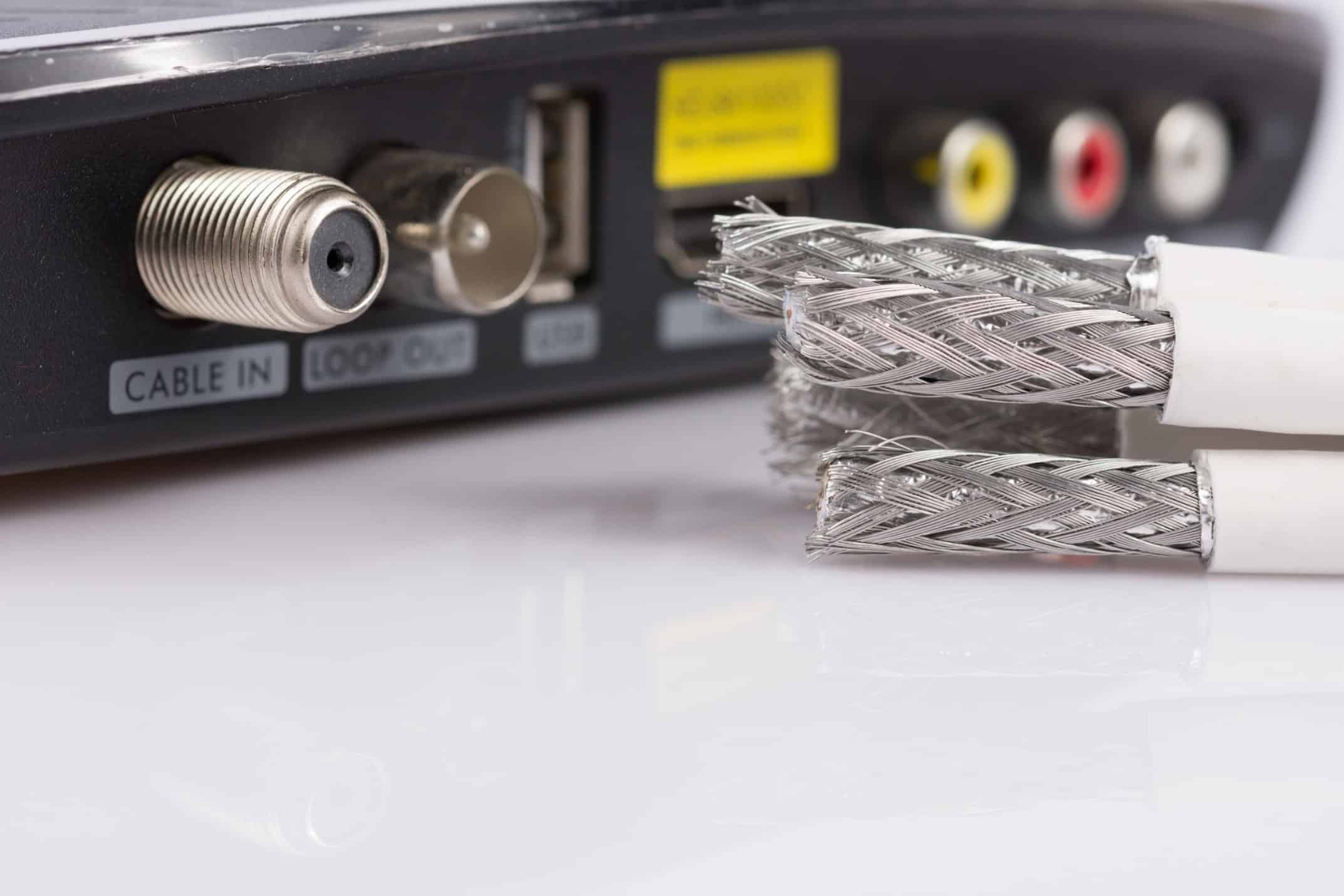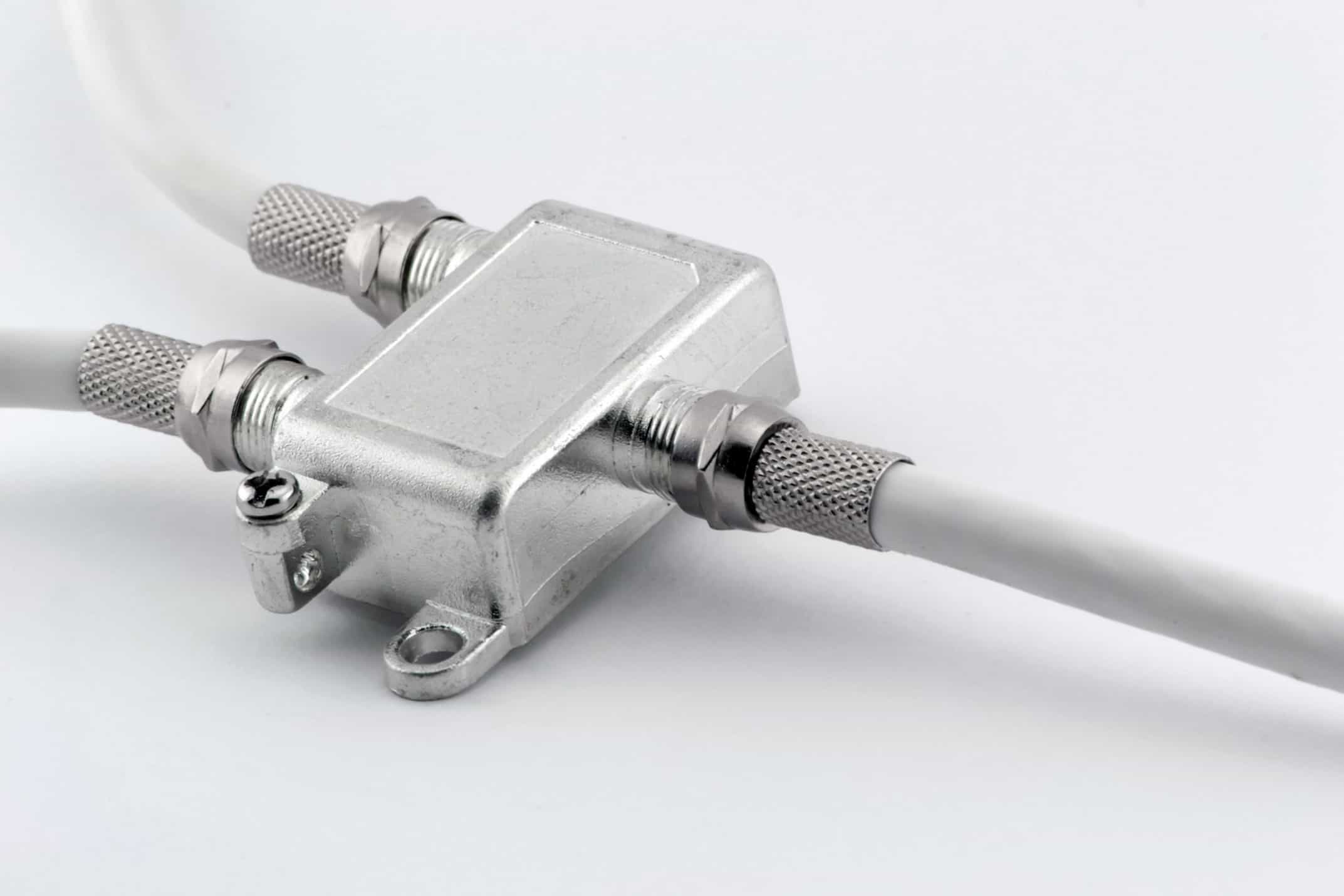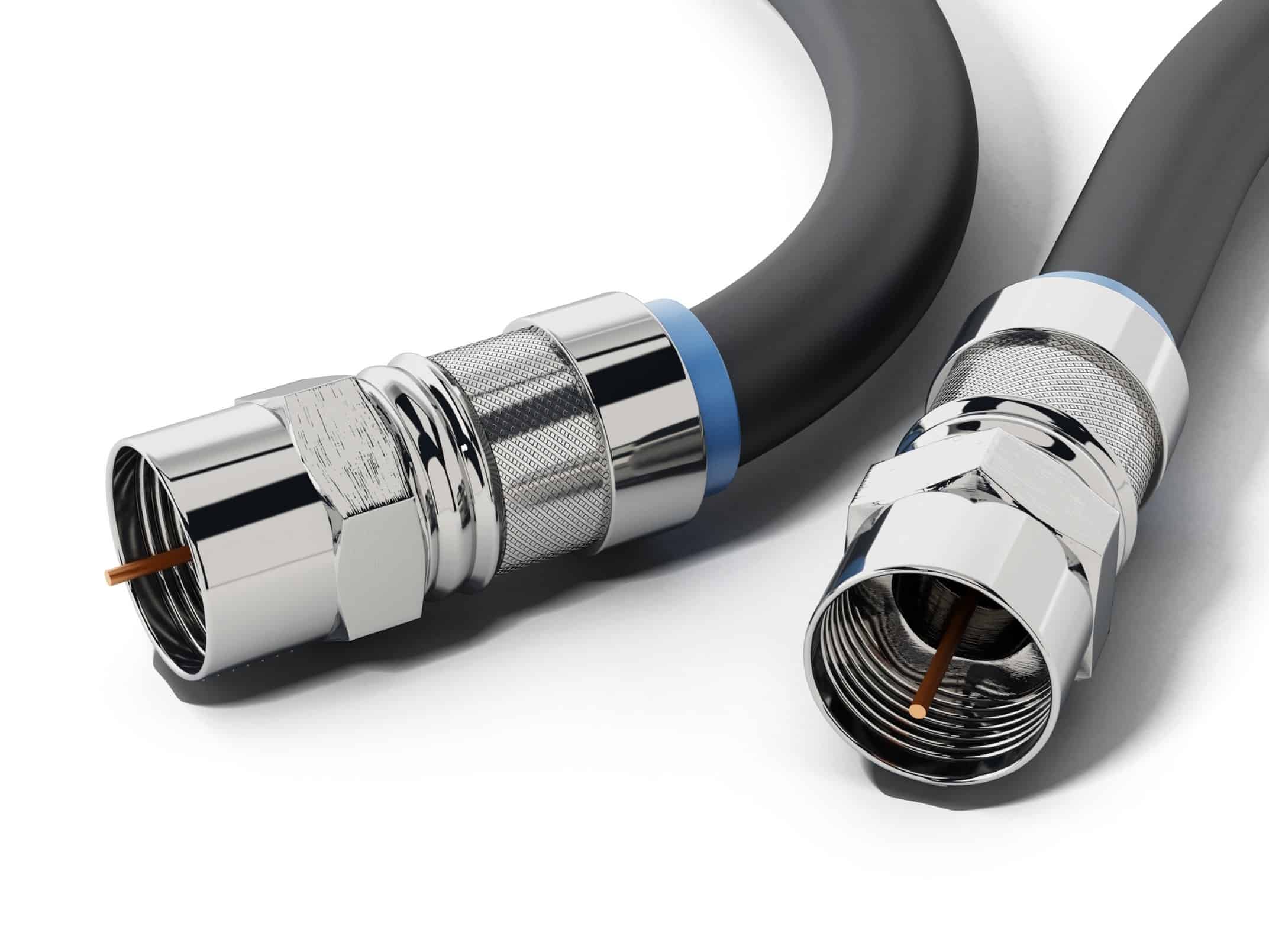The way we watch TV has changed thanks to advancements in technology, but one thing hasn’t changed: You still need to deal with the occasional wire cable. That’s true regardless of if you stream exclusively or still subscribe to cable TV. For this piece, we’re going to focus on demystifying coaxial cables. Read on for some answers to common questions about coaxial cables.
What Is a Coaxial Cable?
A coaxial cable is a type of electrical cable. You’ve seen them sticking out of TVs, Internet routers,and other electronics around the home. You can recognize it by the metallic connector at the end. This connector is usually silver-plated, though it can also be gold. Inside of the connector is a little prong. It looks like this:
Let’s talk about what’s inside! (Or not — if you don’t care, feel free to skip down to the next section for more practical information, like what the heck these things are used for.)
The name “coaxial” comes from the fact that it has two elements sharing a “geometric axis.” That sounds fancy, but it actually just means there are two things in here — an inner core and a “conductive shielding,” both made of copper — that are going the same way.
The “two things going the same way” idea was a big deal back in 1858, which was when this thing was invented. That’s right: The next time you’re wrestling with a coaxial cable, you should stop and appreciate that the thing you’re cursing at was invented before the Civil War.
Coaxial cables transmit signals. In the 20th century, that meant they were used for things like radio and telephone networks. Nowadays, coaxial cables are used across much shorter distances: You’re most likely to spot them inside the home, where we use them for things like data, video, audio, and even the internet.
What Are Coaxial Cables Used For?
Like we just mentioned, coaxial cables (or “coax” if you don’t feel like saying the entire word) are used to transmit data, video, and audio. For instance, a cable box can use a coaxial cable to connect to a TV. This is why the coaxial cable gets a bad rep in stock images related to cord-cutting.

The fact is, however, you’re going to keep seeing these bad boys around long after you “cut” the one connecting your cable box to your TV. Among other places, you might see coaxial connections on:
- Internet modems
- Cable boxes
- Over-the-air antennas
- DVD players
- Stereos
Take an antenna, for instance. If you’re going to get free TV with an antenna, you’ll first need to use a coaxial cable to connect it to your TV. But not to worry; there’s a port for that, and if you look on your TV, which port to use shouldn’t be a secret. You’ll see that unique threaded metal bit sticking right out of the back of your TV, just waiting for its coaxial cable partner.

The connector is often labeled, too. On my TV, it says “CABLE ANT” by the right port. That’s not a new mascot cooked up by cable companies (though I would be excited to meet the Cable Ant): it just means that I’d use the same port to connect either a cable box or antenna. I don’t have a cable box, so antenna it is.
What’s a Coaxial Cable Splitter Do?
If you’ve got one cable outlet and a connection that needs to reach two different devices, then guess what? It’s time to get a coaxial cable splitter. This is most common among people who, for instance, need to get their Internet and TV from the same connection.

If you’re splitting your signal, be aware that you’re reducing the strength of your connection. If you’re only splitting it two ways, you’ll probably be OK. If you start splitting it three or four ways, though, then you might run into problems (though you could try to remedy this by adding some amplifiers, which we’ll talk about in a moment).
Another thing that you should know is that while a simple splitter will help you run the same signal to multiple devices, it won’t let you do the opposite: To run multiple coaxial signals to the same coaxial jack, you’ll need a switcher, rather than just a splitter. Luckily, these things exist as well: You’ll find simple two-way ones (which look just like splitters with a switch on top of them) as well as more complex ones with lots of inputs and buttons on them.
Why Isn’t My Coaxial Cable Working Right?
So you’ve hooked up your coaxial cable to the right ports, but you’re still not getting TV or internet. What should you do?
First, check a few things. Is the TV on? (Sorry, but we have to ask.) Are all your other devices on as well? Then, double-check the ports so you’re absolutely positive the coaxial cables are where they need to be. Check the inner wire inside the cord, too. If it’s bent, it might not be going into the little hole in the coaxial jack. Without that, the coaxial cable won’t function.
Unfortunately, coaxial cables are subject to wear and tear. They’re more delicate than they might appear, and they don’t handle bending and twisting quite as well as some of their more modern counterparts. Once you’ve looked at the inner wire, check for signs of fraying on the cable. While you’re at it, check the metallic connector portions at the end of the coaxial cable. If that’s damaged somehow, then you probably need to replace your coaxial cable with something new.
Some coaxial cables last longer than others. Look for “low loss” cables that have better shielding, because that better shielding makes them a bit more resilient. That said, you shouldn’t do things like step on your coaxial cable or store it in extreme temperatures. No cable will last forever, but taking good care of your coaxial cable is the best thing you can do to ensure it has a longer life.
Finally, remember that it’s not always just about the cable. Consider device-specific troubleshooting. If you’re having trouble with an internet modem, reboot the modem and consider contacting your ISP for help. If you’re dealing with an antenna, you could try our antenna troubleshooting tips. One option with an antenna is to add an amplifier to the setup. An amplifier is a little device that does exactly what it sounds like: It amplifies the signal!
Which Coaxial Cable Should I Use for My TV?
Coaxial cables all look pretty much the same, but is there a special one to look for when it’s time to go buy one for your TV?
The short answer is that you probably don’t have to worry about it. While there are differences in coaxial cable types, they’re not generally going to affect compatibility: Some might be “better” than others, but they’re pretty much all always going to work for the typical things we use coaxial cables for. But if you’re committed to always getting the very best, you could pay attention to the specific type of coaxial cables on the market.
There are more than three types of coaxial cables, but there are three that you’ll see most commonly. Those are the RG6, RG11, and RG59. Those may sound like rejected Star Wars characters, but they’re not. You won’t find a droid named RG6 popping up in The Mandalorian anytime soon.
Instead, RG stands for “radio guide.” The higher the number, the thinner the conductor in the middle of the cable is. So of the most common types, the RG6 would be the thickest cable, and the RG59 would be the thinnest.
What does that mean for you, the person who is just trying to connect a coaxial cable or two in their home? In general, the RG-59 is better if the cable is going just a short distance. If you only need a four-foot or six-foot coaxial cable to get things connected, RG59 should work fine.
What if you’re using a coaxial cable that’s longer than a few feet? If you’re hooking up, say, a 25-foot coaxial cable, it’s worth considering an RG11. They generally handle distance better than the other types. They also work well for HD connections, So if you’re asking “How do I use coaxial cables for HDTV?,” start by finding an RG11.
The largest of inner conductors can be found inside an R6 coaxial cable. If getting an amazing signal quality is your top concern, then this is probably your best bet.
What’s The Difference Between Coaxial and Fiber Optic Cables?
Coaxial cables have been around longer and are cheaper to use. Fiber optic cables cost more but also last longer. For that extra cost, you get better bandwidth, which means the data gets transferred faster on a fiber optic cable than it does with a coaxial cable. Coaxial cables are made of copper, whereas fiber optic cables are made of very small glass fibers. Those glass fibers can transmit data literally at the speed of light. Copper is a good option for most homes, but it’s definitely not as fast as light.
You will often but not always hear about fiber optic cables used more in a business context. Fiber optic Internet is available in some parts of the country, and it’s popular in part because it’s blazingly fast.

